Gloriosa lilies tainted by memories of unwelcome rodents?
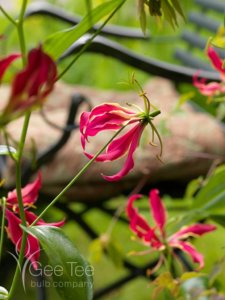
Gloriosa superba ‘Rothschildiana’. Photo credit Gee Tee Bulbs
I have loved Gloriosa Lilies since I saw some arranged in a stylish crystal bowl at a posh restaurant. Reluctantly I decided that I really needed a suitable conservatory or greenhouse to be able to keep them cosy enough to thrive.
This week, with the completion of my greenhouse 3 weeks away, I decided to take the plunge. I bought 5 plump looking tuburs. They were from the online supplier Gee Tee Bulbs, who I’d seen were having a summer bulb sale. The firm tuburs, the length of my little finger, arrived the very next day. They cost only £8.40. I considered it a small price to pay for five plants I’d long yearned for.
They were easy to pot up in pots of compost, lying on their sides. I have only two heated mats, currently in the dining room, and I have moved two of my dahlias to make way for the Gloriosas. I shall be checking them daily and can’t wait to see the first shoots.
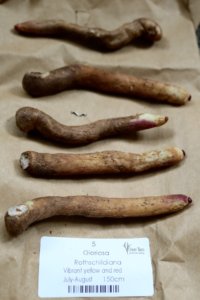
Five healthy Goriosa Superba tuburs
Meanwhile, I was interested to learn more about the origins of the ‘Rothschildiana’ name. They are named after Lionel Walter, the Second Baron Rothschild, who lived 7 miles from me at Tring Park.
His name is mud in our neighbourhood for reasons I’ll explain.
A keen naturalist, he collected thousands of live and stuffed specimens of birds, plants and mammals from around the world and bequeathed his collection to the British Museum. His big mistake was to release live Edible Dormice (glis glis), not native to the UK, into the woods at Tring Park.
They look a bit like grey squirrels, but with bigger bushier tales and huge cute eyes and were considered a delicacy in ancient Rome. Just as the Romans rampaged across Europe, so glis glis are running riot and conquering the woodlands of the Chilterns and beyond.
Unfortunately they are partial to warmth for hibernation and the cold woods don’t really offer this. So they take up residence in lofts and throw rowdy parties, munching your wires for canapes. A friend of mine came face to face with one in her airing cupboard, curled up in her sheets after a particularly heavy night of revelry.
We have been lucky that renovations of our house enabled us to block up the places where they could get in and so far they haven’t returned to our cosy loft in the autumn to hiberante.
They still cause trauma to many of my friends though. I find it hard to forgive Baron Rothschild for introducing this invasive, non native, species. Maybe the beautiful Gloriosa superba ‘Rothschildiana’ will go some way to making amends.
Vegetable Patch Planning
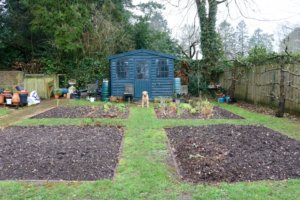
Veg patch – looking ready – but I’m not really able
This week I made a very hard decision. I’m going to cut in half the number of vegetables I grow this year.
Whilst I love growing my own, deep down I know it is time consuming and many parts of my garden are neglected whilst I tend my veg. I have shared with Six on Saturday readers my plans for a new woodland path and of course my new greenhouse. They must come first this year.
As you can see, a bed and a half are occupied by perennials displaced by my geenhouse build, which will need moving back when it’s finished. I have eight squash plants that have just germinated on the kitchen windowsill and these will romp away on one of the beds, smothering the weeds and producing some tasty fruits for winter storing.
I will also grow climbing french beans and runners as they are pretty low maintenance and it’s a quick but fun job to build the bamboo wigwams and plant some seeds at the base. I will also grow some jerusalem artichokes – as I love the soup – and will maintain the globe artichokes and asparagus that are already there.
That’s it.
Yikes, I feel rather queasy at the thought of such a minimalist approach but I must hold the line…
Secret squirrel bird table
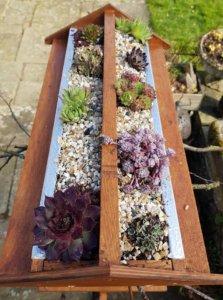
The roof of my daughter’s squirrel proof bird table
Your mission – should you choose to accept it – is to design and build a squirrel proof bird table.
My eldest daughter chose to accept this mission as part of her GCSE Design and Technology coursework.
The finished product is currently being tested in our garden and I can report that it is squirrel proof. The only problem is that so far we think it may also be bird proof, although my son reported seeing a blue tit in, on, or near it.
It really is a secret squirrel operation as I can’t share a picture of it. My daughter hopes that she will crack the design, go on Dragon’s Den, sell millions and make her fortune.
What I can share is the roof, which very pleasingly she designed as a mini planter. This week we visited our local nursery, which stocks some lovely succulents.
She planted it up and I think it looks lovely. I managed to take a few offsets from the sempervivums which I’ll grow on for the future. Win win for us but I fear the birds may be losing out.
Bringing my Colocasia back into growth
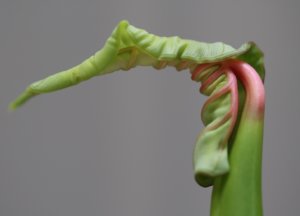
This time last year I bought three Taro or Colocasia Esculenta tuburs to add drama to my tropical border. They have an edible root and are a staple food in many parts of the tropics – but my interest in them is purely aesthetic. They’re not known as Elephant’s Ear for nothing.
They did very well but I knew I couldn’t keep them going outdoors in winter. For a while I entertained the thought as keeping them as houseplants and I potted them up and brought them into the house.
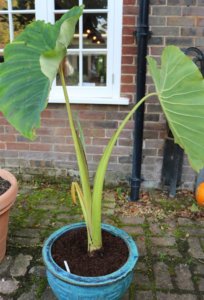
Colocasia Esculenta potted up ready to fail as a houseplant
They hated it indoors, looked immediately ill, and I knew I had to lift them, wash them, dry them and store them as I would dahlia tubers.
I potted them up in February and they’ve been taking up valuable space on one of my heated mats. This week I was rewarded with a beautiful new shoot. It’s pea green, with a pink tinge, and really is rather beautiful. Before long it’ll be a huge dramatic leaf but for now I’m enjoying it’s lilliputian beauty.
Teeny tiny Iris seeds
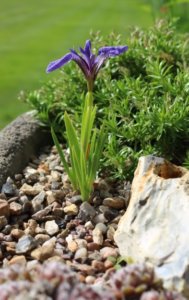
Teeny tiny iris last June
Talking of Lilliput, for the last two years I’ve been thrilled to grow a very small Iris in my alpine trough. It looks just like an ordinary Iris Sibirica but one that has consumed a magic shrinking potion. The complete flower is only 10cm tall.
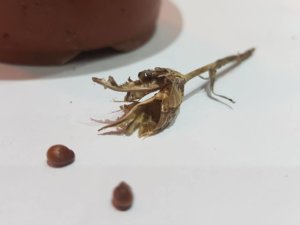
Seed head and seeds of my mini iris
Last autumn I shook the seed pod and was hoping they would germinate naturally in the trough. They still might but this week I picked the seed head off and discovered two shiny chestnut coloured seeds still inside. I’ve put them in a little pot filled with gritty compost and am hoping they’ll germinate.
Fungus Gnat update
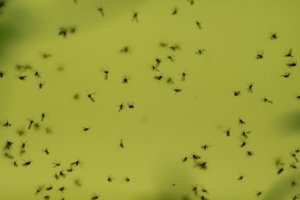
Hundreds of fungus gnats have come to a sticky end on this plastic pads
A few weeks ago I described the plague of fungus gnats that had descended on my kitchen. Complaints from my family had put my urban jungle at risk of forest clearance and I needed to act.
I can report that numbers are now seriously reduced thanks to the rather unattractive plastic sticky pads. These are bright yellow, but leant up against the wall or window they attracted the flies in huge numbers. They are very very sticky indeed so care has to be taken that they don’t stick to your windows, plant leaves or worse – paintwork.
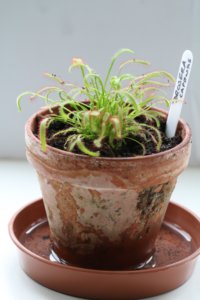
Sundew – Drosera capensis
As promised I did also buy a new carniverous plant. I am yet to find a Pinguicula but this Sundew or Drosera was easy to find at a local garden centre. It hasn’t caught as many as the yellow plastic but is so delicate and pretty.
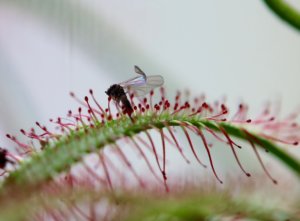
This Fungus gnat came to a sticky end on a Sundew leaf
Six on Saturday is a weekly meme – take a look at the comments at the base of host The Propagator to see more ‘sixes’ from other keen gardeners from all over the world.
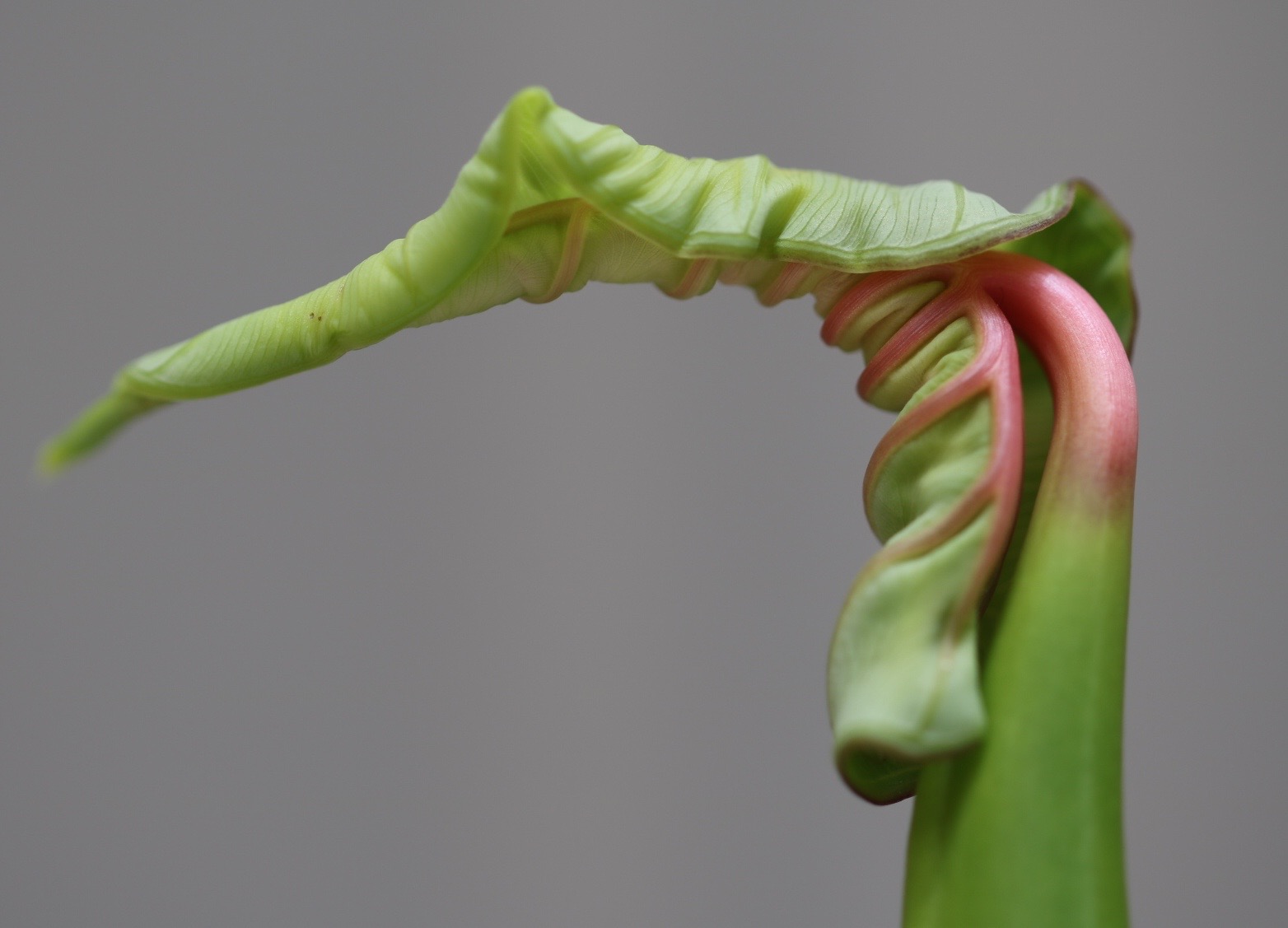

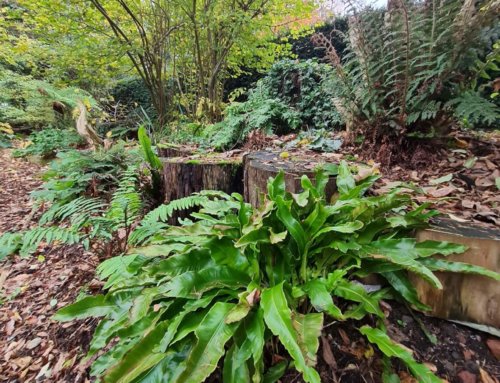
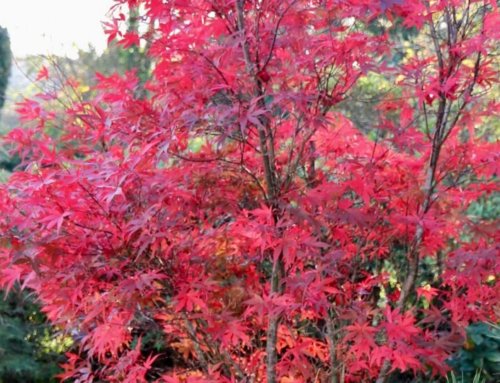
What an informative post. I look forward to progress reports on the squirrel-proof bird table. Don’t worry about the lack of birds – it can take a surprisingly long time for them to discover a new food source. When I removed my bird table (due to a killer cat, not squirrels) and hung up feeders no more than 30 feet away, it took a couple of months before birds returned in numbers to use them. I stopped growing veg about 5 years ago and fruit the year before last. There’s a good farmers’ market nearby where I can get nice fresh produce without all the effort. For indoor fly trapping, have a look at https://amzn.to/2E8r743 .. They’re much better to look at than those yellow sheets.
Thanks John. I’ve looked up those fly traps and yes the butterfly shapes are much more attractive. I have a bulk order of huge oblong ones to get through. I should maybe cut them into nice shapes myself. You’re right about the bird table and I can report that the birds are now finding their way in. We’re all elated!.
So many exciting things happening! I love all your exotics, because apart from dahlias and annuals I don’t grow any tender plants. Love that bird feeder!
Thanks Ali – I really don’t know why I’m so attracted to tender perennials as they do require a bit of attention and like all of us I’m not overly blessed with spare time. I’m hoping my new greenhouse will make things a bit easier when it comes to overwintering.
Another wonderful photo that this close-up of Colocasia … You will tell me if your Drosera survives with all the gnats it will catch. Mine died after 2 months inside as if it had eaten too much ..
About, the roof of squirrel proof bird table, I like it…! Congratulations to her !
Hi Fred, I think I’ll move the Drosera outdoors soon to avoid death by gnat ingestion. To be honest the ugly yellow things have caught far more anyway. My daughter is so pleased with her project and I have to admit I’m very impressed with her handiwork. It even has adjustable spinning feet for uneven paving.
The secret squirrel bird table looks stunning from the top! Hopefully the birds will figure it out, and the squirrels will still be unable to get to the food 🙂
Thanks Paddy, I can report that the blue tits have found their way in so it works and yes those succulents are just the job. I’m planning more alpine receptacles for the offsets…
What a great post! Love the gloriosa lillies I must get some this year! The tiny iris is so cute, is that it’s fully grown size? The little green roof will look great , looking forward to seeing how that delevops
Thanks Thomas, it’s strange to be finally growing some gloriosas after years of longing and yes that Iris is full sized, just 11cm tall. I wish I had kept the label so I could tell you what it is. I will dig about online and in my books and failing that will take to twitter – someone will know!
After a Google image, I can see why old Lionel fell in love w/his dormice. They sound like raccoons but w/o the opposable thumbs. That colocasia photo is stunning. As to your veg garden, I think we all have years where hard decisions have to be made. Hopefully your woodland path will make up for the cutback & of course, what’s better than a new greenhouse? Lovely photos, all round.
Thanks Lora. I keep thinking of all the things I won’t be growing and thinking…maybe…just a few but you’re right I’ll have plenty of new adventures to look forward to.
I love the picture of the Colocasia. It looks like it’s got its hand drill out to help build the bird table.
Yes Susurrus – You’re right it does!
Wonderful idea from your daughter regards the Squirrel proof bird box. Think the planting on top of it is fantastic
How interesting about the glis glis of Tring – just shows what can happen when you mess with nature.
Very impressed by your daughter’s bird feeder – good luck with Dragon’s Den!